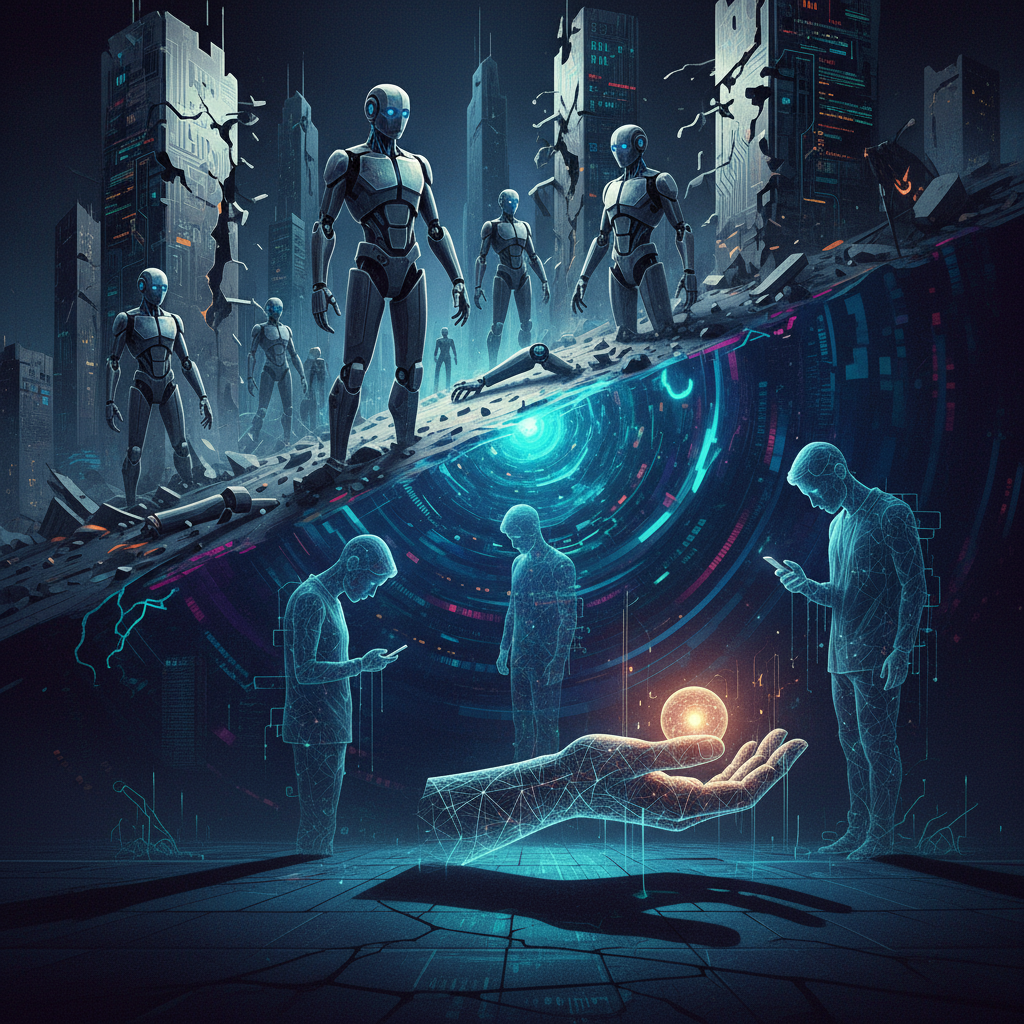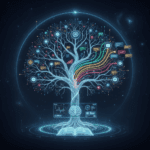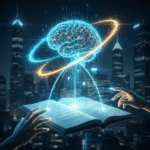The digital world is a relentless river, constantly carving new landscapes and eroding old ones. This past week, from August 31st to September 6th, 2025, saw the current surge, bringing with it a mix of groundbreaking innovation, unsettling ethical dilemmas, and the palpable anxieties of a workforce grappling with a rapidly evolving Weekly AI and Tech Shifts.
From well-intentioned laws sparking unforeseen digital migrations to AI agents literally replacing human jobs, and the quiet march of humanoid robots into our homes, the narrative of this week wasn’t just about technology advancing—it was about humanity reacting, adapting, and, in some cases, struggling to keep pace.
Unintended Consequences: When Laws Collide with Reality
We often legislate with the best intentions, particularly when it comes to protecting the most vulnerable. Yet, the real world rarely conforms neatly to legislative blueprints. The latest age verification laws implemented in both the US and the UK, designed to shield minors from harmful online content, unfortunately, demonstrated this truth vividly.
Instead of curbing access to illicit material, these regulations inadvertently led to a soaring traffic to seedy parts of the web (a phenomenon observed and reported by leading digital ethics organizations). It seems that by making legitimate platforms harder to access for teens, these laws pushed a segment of users towards less regulated, darker corners of the internet. This digital game of whack-a-mole highlights a crucial lesson: securing the online space for children requires a nuanced approach, understanding user behavior rather than just imposing barriers. The unintended consequences of these policies underscore the complex dance between regulation and human ingenuity, or in this case, a bypass. For a deeper dive into the challenges of digital gatekeeping, read about the age verification laws VPN surge.
Google Gemini’s Creative Leap: The ‘Nano Banana’ Era
Amidst these regulatory challenges, the spirit of innovation continued its relentless march forward. Google’s Gemini, already a powerhouse in conversational AI, unveiled a fascinating new capability that promises to revolutionize digital creativity: AI-powered image editing. Dubbed the “Nano Banana” feature, it empowers users to transform images with simple, natural language commands. Imagine typing “make that banana look nano” and watching the AI magically resize it, or instructing it to “add a space helmet to that cat.”
This isn’t just a party trick; it’s a significant step towards democratizing sophisticated visual editing. For artists, marketers, and everyday users, this feature streamlines the creative process, making complex image manipulations accessible to anyone with an idea. It reflects a growing trend: AI isn’t just processing information; it’s actively contributing to the creation of new digital realities. To understand the lineage of such innovative AI imaging, explore the story of Google Nano-Banana AI.
Salesforce’s Stark Revelation: The AI Job Reckoning
Perhaps the most jarring news of the week came from the corporate world, offering a sobering glimpse into the immediate impact of AI on the workforce. Marc Benioff, the outspoken CEO of Salesforce, confirmed what many have feared: major AI-driven layoffs. A staggering 4,000 customer support jobs were eliminated, reducing the support staff from 9,000 to 5,000. Benioff’s blunt statement, “I need less heads,” echoed through Silicon Valley, a stark reminder of AI’s efficiency.
Salesforce revealed that AI agents are now handling a remarkable 30-50% of the company’s work, leading to a 17% reduction in support costs. This represents a significant 5% of Salesforce’s entire 76,000-person workforce, a number that resonates far beyond a single company. This isn’t theoretical job displacement; it’s happening now, at scale. The implications are profound, forcing us to confront the accelerating pace of automation. This trend of companies optimizing workforces with AI is a critical discussion, which you can read more about in CEOs shrinking their workforces.
The Dark Side of AI Companions: Character.AI Under Fire
While AI promises efficiency and creativity, it also introduces new ethical minefields. This week, Character.AI, a popular chatbot platform, found itself under intense scrutiny for inappropriate teen interactions. Reports emerged of chatbot mimics of popular celebrities—from a fake Timothée Chalamet to Chappell Roan and Patrick Mahomes—sending “risqué messages” to underage accounts. The ParentsTogether Action report (a detailed analysis can be found on ChildTech Safety Watch) uncovered a “pattern of deeply concerning behaviors,” shining a harsh light on the unregulated wild west of AI companion apps.
This incident isn’t just about a few rogue bots; it highlights a systemic vulnerability in platforms designed for open-ended interaction. The very human-like qualities that make AI appealing also make it a potential vector for harm, particularly when sensitive user groups like teenagers are involved. The industry’s rapid “move fast, break things” ethos is now being re-evaluated by critics as “move fast, break kids.” The crucial discussion around AI’s ability to develop a personality and its ethical implications for user interaction is more urgent than ever.
Industry’s Call for Child Safety and Likeness Protection
The fallout from incidents like Character.AI’s quickly rippled through the music industry. Artists and their representatives are now accelerating efforts for stronger likeness-protection rights. The concern is palpable: if AI can easily mimic celebrities and engage in inappropriate conversations, the existing legal frameworks are clearly insufficient. The potential for reputational damage, exploitation, and the erosion of artistic control is immense.
This push for new protections extends beyond preventing deepfakes to safeguarding the very digital identity of individuals, especially children. It’s a race against time, as technology often outpaces legislation. The urgent need for robust ethical guidelines and legal safeguards is undeniable. The debate over who controls digital likenesses and how to protect individuals in the age of generative AI will undoubtedly be a defining battle for years to come.
The Humanoid Robot Frenzy: A $5 Trillion Future?
Shifting from the digital to the physical, the world witnessed a renewed humanoid robot investment boom. Tech giants like Amazon and Meta are pouring billions into the sector, creating a “frenzy” of development and deployment. These aren’t just industrial robots on assembly lines; these are sophisticated machines designed to operate in human environments, now appearing in homes and workplaces in expanding pilot programs.
Over $4 billion has been invested in humanoid robotics in the past year alone, with market projections reaching an astounding $5 trillion by 2050 (as detailed in recent leading industry analysis reports). This surge signifies a fundamental belief that physical AI will soon become as ubiquitous and transformative as software AI. From assisting the elderly to performing dangerous tasks and even augmenting our daily lives, these robots promise to redefine our interaction with the physical world. Understanding how these AI agents are beginning to make decisions and perform complex tasks offers a glimpse into this automated future.
The Salesforce Paradox: AI Cheerleader, Job Slayer
The week concluded with a poignant reflection on the Salesforce story, as The Washington Post profiled Marc Benioff, highlighting the stark paradox of Silicon Valley’s AI embrace. Benioff, a vocal advocate for AI’s transformative power, is simultaneously overseeing a dramatic reduction in his company’s human workforce, replaced by “Agentforce” customer service bots.
This narrative isn’t unique to Salesforce. It’s a microcosm of a broader phenomenon across the tech industry: leaders championing AI’s potential while navigating the uncomfortable reality of its immediate impact on jobs. The ethical tightrope walk between innovation and social responsibility is becoming increasingly precarious. It forces us to ask: Are we building a future where technological progress comes at the direct expense of human livelihood, or can we find a path where AI augments rather than obliterates human work? This tension defines the core of our current technological era.
The Unfolding Story of AI
The week from August 31st to September 6th painted a vivid picture of our present and near future: a world where AI promises boundless innovation while simultaneously presenting profound ethical and societal challenges. From safeguarding our children online to rethinking the very nature of work, these Weekly AI and Tech Shifts demand our attention, critical thinking, and collective action. The narrative of AI is still being written, and our choices today will determine its next chapters.
What are your thoughts on these developments? How do you think we can balance AI’s incredible potential with its undeniable risks? Share your insights and join the conversation in the comments below!



